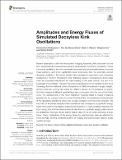Amplitudes and energy fluxes of simulated decayless kink oscillations
Abstract
Recent observations with the Atmospheric Imaging Assembly (AIA) instrument on the SDO spacecraft have revealed the existence of decayless coronal kink oscillations. These transverse oscillations are not connected to any external phenomena like flares or coronal mass ejections, and show significantly lower amplitudes than the externally excited decaying oscillations. Numerical studies have managed to reproduce such decayless oscillations in the form of footpoint driven standing waves in coronal loops, and to treat them as a possible mechanism for wave heating of the solar corona. Our aim is to investigate the correlation between the observed amplitudes of the oscillations and input the energy flux from different drivers. We perform 3D MHD simulations in single, straight, density-enhanced coronal flux tubes for different drivers, in the presence of gravity. Synthetic images at different spectral lines are constructed with the use of the FoMo code. The development of the Kelvin-Helmholtz instability leads to mixing of plasma between the flux tube and the hot corona. Once the KHI is fully developed, the amplitudes of the decayless oscillations show only a weak correlation with the driver strength. We find that low amplitude decayless kink oscillations may correspond to significant energy fluxes of the order of the radiative losses for the Quiet Sun. A clear correlation between the input energy flux and the observed amplitudes from our synthetic imaging data cannot be established. Stronger drivers lead to higher vales of the line width estimated energy fluxes. Finally, estimations of the energy fluxes by spectroscopic data are affected by the LOS angle, favoring combined analysis of imaging and spectroscopic data for single oscillating loops.
Citation
Karampelas , K , Van Doorsselaere , T , Pascoe , D J , Guo , M & Antolin , P 2019 , ' Amplitudes and energy fluxes of simulated decayless kink oscillations ' , Frontiers in Astronomy and Space Sciences , vol. 6 , 38 . https://doi.org/10.3389/fspas.2019.00038
Publication
Frontiers in Astronomy and Space Sciences
Status
Peer reviewed
ISSN
2296-987XType
Journal article
Description
KK, TVD, and DP and were funded by GOA-2015-014 (KU Leuven). MG is supported by the China Scholarship Council (CSC) and the National Natural Science Foundation of China (41674172). PA acknowledges funding from his STFC Ernest Rutherford Fellowship (No. ST/R004285/1). This project has received funding from the European Research Council (ERC) under the European Union's Horizon 2020 research and innovation programme (grant agreement No 724326).Collections
Items in the St Andrews Research Repository are protected by copyright, with all rights reserved, unless otherwise indicated.

